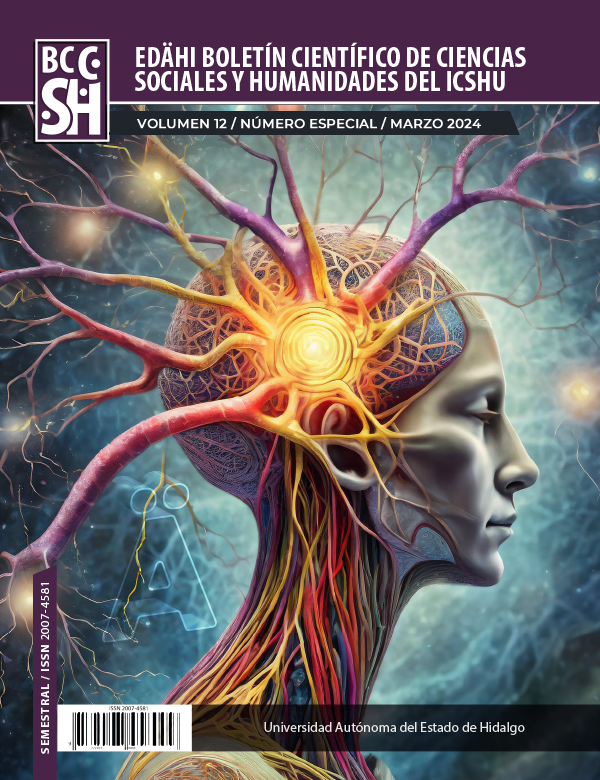Living heritage and experimental culture: redefinition of heritage through the participation of the inhabitants of El Bordo, Pachuca, Mexico
DOI:
https://doi.org/10.29057/icshu.v12iEspecial.11562Keywords:
Experimental culture, living heritage, cultural mediation, oral narrativesAbstract
This document analyzes the re-signification of heritage through a participatory process promoted by the inhabitants of El Bordo, a small community in central Mexico, in collaboration with various citizen groups between 2021 and 2023. The analysis focuses on two projects guided by experimental culture and the notion of living heritage: the El Bordo Citizen Lab (LCB) and the El Bordo, Architectures for Memory project, which resulted in the construction of the public transport stop called the El Bordo Urban Equipment Module. The community of El Bordo is located in the northern region of Pachuca de Soto, Hidalgo, Mexico. It is part of a landscape defined by mining activities for over five centuries and in which multiple heritage elements have been historically undervalued. The community is part of a periphery that faces deep social problems, such as inadequate basic services and limited access to fundamental rights.
The article begins by describing the post-mining context in which El Bordo is located. Subsequently, the text delves into the characteristics of the town and recounts the participation actions that have occurred in it. It then explores the notions of living heritage and experimental culture, focusing on the two initiatives above: the LCB and the El Bordo Architectures for Memory project. Finally, the article shares the lessons learned from this participatory process, which achieved the construction of a common good through social innovation.
Downloads
References
Aguilar, Y. (2023). La gran pirámide de Giza del capitalismo. Extractivismo. Revista de la Universidad de México. Núm. 896. 40 - 45.
Benítez, F. (1996). El peso de la noche. Nueva España de la edad de plata a la edad de fuego. México. Ediciones Era.
Canet, C. y García, A. (2021). Guía de geositios de la Comarca Minera. Universidad La Salle Pachuca. México.
Cruzvillegas, A. (2014). La voluntad de los objetos. México. Sexto Piso.
DeCarli, G. (2018). El patrimonio, su definición, gestión y uso social. Fundación ILAM. San José Costa Rica.
Hassan, Z. (2014). The Social Labs Revolution. A new approach to solving our most complex challengues. San Francisco: Berret- Koehler.
Herrera, Y. (2017). El incendio de la Mina de El Bordo. Periférica. España.
Hernández, A. (2016). Los proyectos académicos de intervención sociocultural, en Mac Gregor J.A. Proyectos culturales: sus configuraciones y desafíos para el cambio social. Intersecciones. Secretaría de Cultura. México.
Hersch Martínez, P. (2018). Patrimonio cultural y participación social: una articulación imprescindible. Diario De Campo, (2), 7–26. Recuperado a partir de https://revistas.inah.gob.mx/index.php/diariodecampo/article/view/11866
Humboldt, A. (2014). Ensayo político sobre el reino de la Nueva España. México. Porrúa .
Lafuente, A. (2022). Itinerarios comunes. Laboratorios ciudadanos y cultura experimental. NED Ediciones. México.
Lazcano, M. D., y Tellería, Y. 2019. Ruta Arqueológica Minera: La gestión integral del Antiguo Distrito Minero de Pachuca. Congreso de Investigación Aplicada al Turismo 2019, Instituto de Competitividad Turística, Secretaría de Turismo.
Langer, E. (2019). Crisis civilizatoria. Experiencias de los gobiernos progresistas y debates en la izquierda latinoamericana. México: CALAS - Universidad de Guadalajara.
López, L. (2015). La gestión cultural como construcción de ciudadanía. Presentado al Premio Internacional Ramon Roca Boncompte de Estudios de Gestión Cultural. Fira Tàrrega. https://www.firatarrega.cat/media/upload/pdf/lopezborbon_gestion-cultural-como-construccion-de--ciudadania_editora_14_97_1.pdf
Machado, A. (2018). Potosí, el origen. Genealogía de la minería contemporánea. Editorial Abya-Yala. Ecuador.
Medialab Prado. (2020). Laboratorios Ciudadanos. Una aproximación a Medialab Prado. 15 de noviembre del 2021, de Medialab Prado Sitio web: https://www.medialabmatadero.es/sites/default/files/multimedia/documentos/2021- 06/Laboratorios_ciudadanos._Una_aproximacion_a_Medialab_Prado_ESP.pdf
Menes, J.M. (2014). Estudio introductorio en Almaraz, R. Memoria de los trabajos ejecutados por la Comisión Científica de Pachuca en el año de 1864. Maporrúa y Gobierno del Estado de Hidalgo. México.
Ortega, M. (2012). Minería y ferrocarriles en la región de Pachuca y Real del Monte durante el Porfiriato. Universidad Autónoma del Estado de Hidalgo. México.
Pérez, E. (2022). Patrimonio cultural inmaterial. Secretaría de Cultura. Centro de Cultura Digital. México.
R.W. Randall. (1986). Real del Monte: una empresa minera en México. México: Fondo de Cultura Económica.
Oviedo, B., Iwadare, M., y Hernández, M. (2010). Patrimonio industrial minero. Nuevas alternativas para una gran historia. México. Archivo Histórico y Museo de Minería Asociación Civil.
Schwartz, S. (2007). The Cornish in Latin America. Recuperado el 1 de agosto del 2023, de Exeter University Press Sitio web: https://projects.exeter.ac.uk/cornishlatin/workingpapersandbibliography.htm
Segato, R. (2022). Decolonialidad y patrimonio. Parte 1, en Elbirt, A.L. y Muñoz, J.I. Los patrimonios son políticos. RGC Libros. Ministerio de Cultura Argentina. Argentina.
Subirats, J. (2016). Políticas urbanas e innovación social. Entre la coproducción y la nueva institucionalidad. Prácticas significativas en España, en Carrión, F., y Erazo, J. (coords.), Derecho a la ciudad en América Latina: visiones desde la política. Universidad Nacional Autónoma de México. México.




















